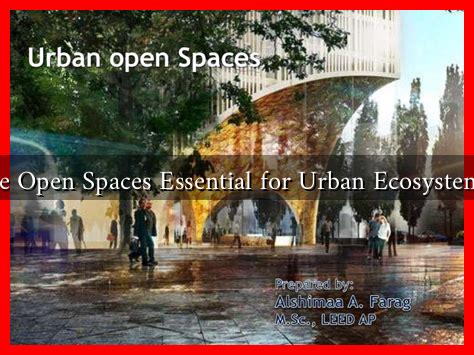-
Table of Contents
Are Open Spaces Essential for Urban Ecosystems?
As urbanization continues to rise, the importance of open spaces in cities has become a focal point for environmentalists, urban planners, and community advocates. Open spaces, which include parks, gardens, and natural reserves, play a crucial role in maintaining the ecological balance within urban environments. This article explores the significance of open spaces for urban ecosystems, highlighting their benefits, challenges, and examples from around the world.
The Role of Open Spaces in Urban Ecosystems
Open spaces serve as vital components of urban ecosystems, providing numerous ecological, social, and economic benefits. Here are some key roles they play:
- Biodiversity Support: Open spaces provide habitats for various species, promoting biodiversity. Urban parks can host birds, insects, and small mammals, contributing to a balanced ecosystem.
- Climate Regulation: Green spaces help mitigate urban heat islands by cooling the air through evapotranspiration. Trees and vegetation absorb carbon dioxide, improving air quality.
- Stormwater Management: Open spaces can absorb rainwater, reducing runoff and minimizing the risk of flooding. This natural filtration process helps maintain water quality.
- Recreation and Well-being: Parks and open areas offer recreational opportunities, promoting physical health and mental well-being among urban residents.
Benefits of Open Spaces
The benefits of open spaces extend beyond ecological functions. They also contribute to social cohesion and economic vitality:
- Community Engagement: Open spaces serve as gathering places for communities, fostering social interactions and cultural events.
- Increased Property Values: Proximity to parks and green spaces often leads to higher property values, benefiting local economies.
- Health Benefits: Access to nature has been linked to reduced stress levels, improved mood, and increased physical activity, leading to healthier populations.
- Tourism and Economic Growth: Well-maintained parks can attract tourists, boosting local businesses and creating jobs.
Challenges in Maintaining Open Spaces
Despite their numerous benefits, open spaces face several challenges in urban settings:
- Urban Development Pressures: As cities expand, open spaces are often sacrificed for new developments, leading to habitat loss.
- Funding and Maintenance: Many urban parks suffer from inadequate funding, resulting in poor maintenance and reduced accessibility.
- Equity Issues: Access to open spaces is often uneven, with marginalized communities frequently lacking nearby green areas.
Case Studies: Successful Urban Open Spaces
Several cities around the world have successfully integrated open spaces into their urban planning, demonstrating their importance:
- New York City’s Central Park: Designed by Frederick Law Olmsted and Calvert Vaux, Central Park is a prime example of how open spaces can enhance urban life. It provides a refuge for wildlife and a recreational area for millions of visitors each year.
- Singapore’s Gardens by the Bay: This innovative project combines nature with urban design, featuring biodomes and vertical gardens that promote biodiversity while serving as a tourist attraction.
- Barcelona’s Superblocks: This initiative aims to reduce car traffic in certain neighborhoods, reclaiming streets for pedestrians and creating more green spaces, thus improving air quality and community interaction.
Conclusion
Open spaces are not merely aesthetic additions to urban landscapes; they are essential for the health and sustainability of urban ecosystems. By supporting biodiversity, regulating climate, managing stormwater, and enhancing community well-being, these areas play a critical role in urban life. However, challenges such as urban development pressures and funding constraints must be addressed to preserve and enhance these vital spaces. As cities continue to grow, prioritizing open spaces will be crucial for creating resilient and livable urban environments. For more information on the importance of urban green spaces, you can visit The Nature Conservancy.



